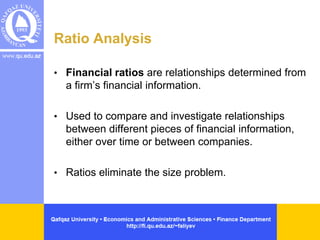Bus class 3 5 ratios
- 1. Ratio Analysis âĒ Financial ratios are relationships determined from a firmâs financial information. âĒ Used to compare and investigate relationships between different pieces of financial information, either over time or between companies. âĒ Ratios eliminate the size problem.
- 2. Categories of Financial Ratios âĒ Liquidityâmeasures the firmâs short-term solvency. âĒ Capital structureâmeasures the firmâs ability to meet long-run obligations (financial leverage). âĒ Asset management (turnover)âmeasures the efficiency of asset usage to generate sales. âĒ Profitabilityâmeasures the firmâs ability to control expenses. âĒ Market valueâper-share ratios.
- 4. Capital Structure Ratios onamortisationdepreciatiafter taxprofitNet debtbearing-Interest flowcashgrossDebt to chargesfinanceInterest EBIT coverinterestNet equityTotal assetsTotal multiplierEquity equityTotal debtTotal ratioyDebt/equit sIntangibleequityTotal CashdebtfinancialTotal ratioydebt/equitNet ïŦïŦ ï― ïŦ ï― ï― ï― ï ï ï―
- 6. Turnover Ratios (continued) assetsTotal Sales overasset turnTotal assetscurrent-Non Sales overasset turnFixed turnoversReceivable days365 sreceivableinsalesDays' ï― ï― ï―
- 8. Market Value Ratios shareperBook value shareperueMarket val ratiobook-to-Market shareperEarnings shareperPrice ratioingPrice/earn ï― ï―
- 9. The Du Pont Identity âĒ Breaks ROE into three parts: â operating efficiency â asset use efficiency â financial leverage multiplierEquityROA multiplierEquityoverasset turnTotalmarginProfit Equity Assets Assets Sales Sales profitNet ROE ïīï― ïīïīï― ïīïīï―
- 10. Uses for Financial Statement Information âĒ Internal uses: â performance evaluation â planning for the future âĒ External uses: â evaluation by outside parties â evaluation of main competitors â identifying potential takeover targets
- 11. Benchmarks for Comparison âĒ Ratios are most useful when compared to a benchmark. âĒ Time-trend analysisâexamine how a particular ratio(s) has performed historically. âĒ Peer group analysisâusing similar firms (competitors) for comparison of results. âĒ Global Industry Classification Standard (GICS) used by ASX is a useful way to find a peer company.
- 12. Problems with Ratio Analysis âĒ No underlying theory to identify correct ratios to use or appropriate benchmarks. âĒ Benchmarking is difficult for diversified firms. âĒ Firms may use different accounting procedures. âĒ Firms may have different recording periods. âĒ One-off events can severely affect financial performance.











